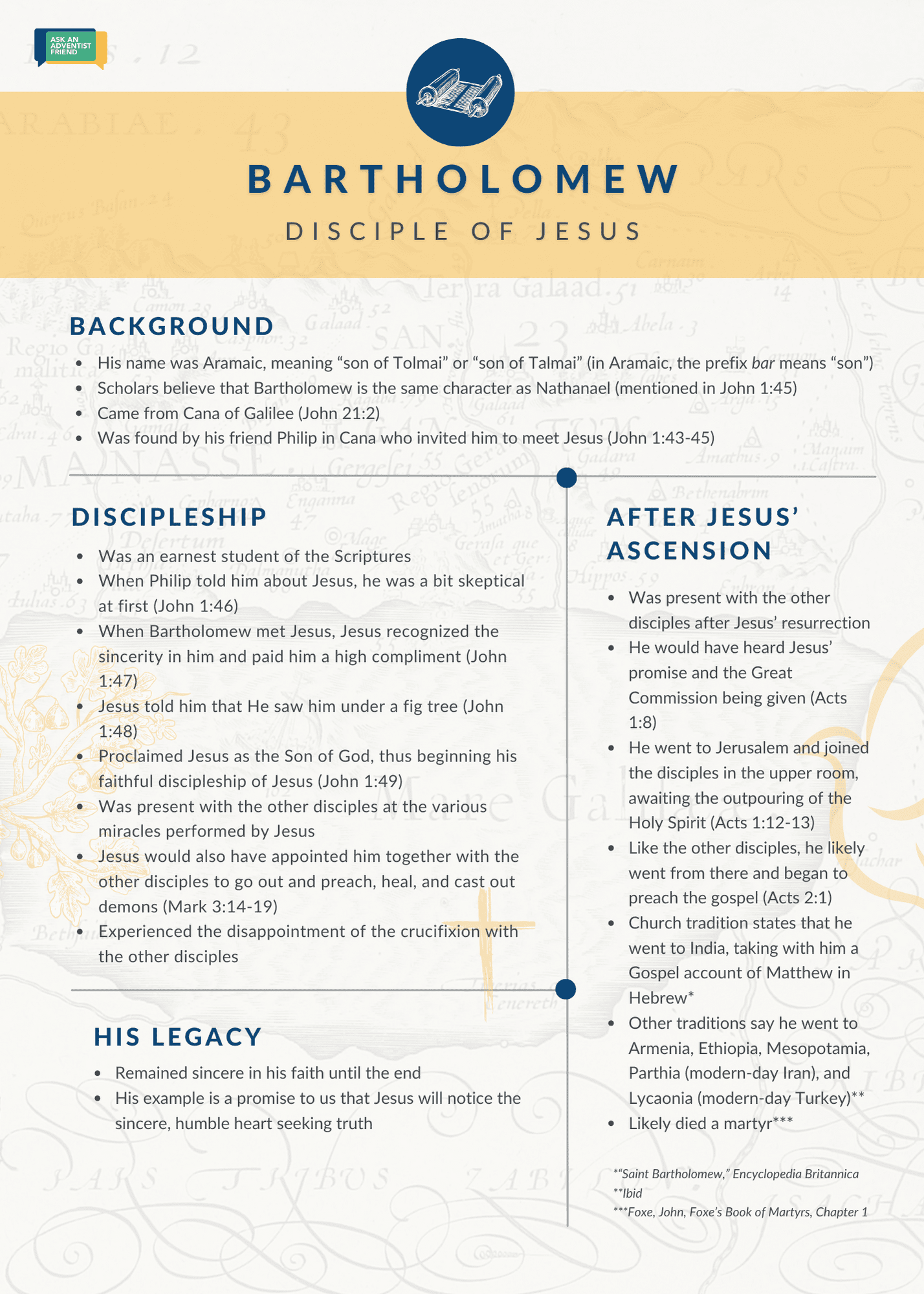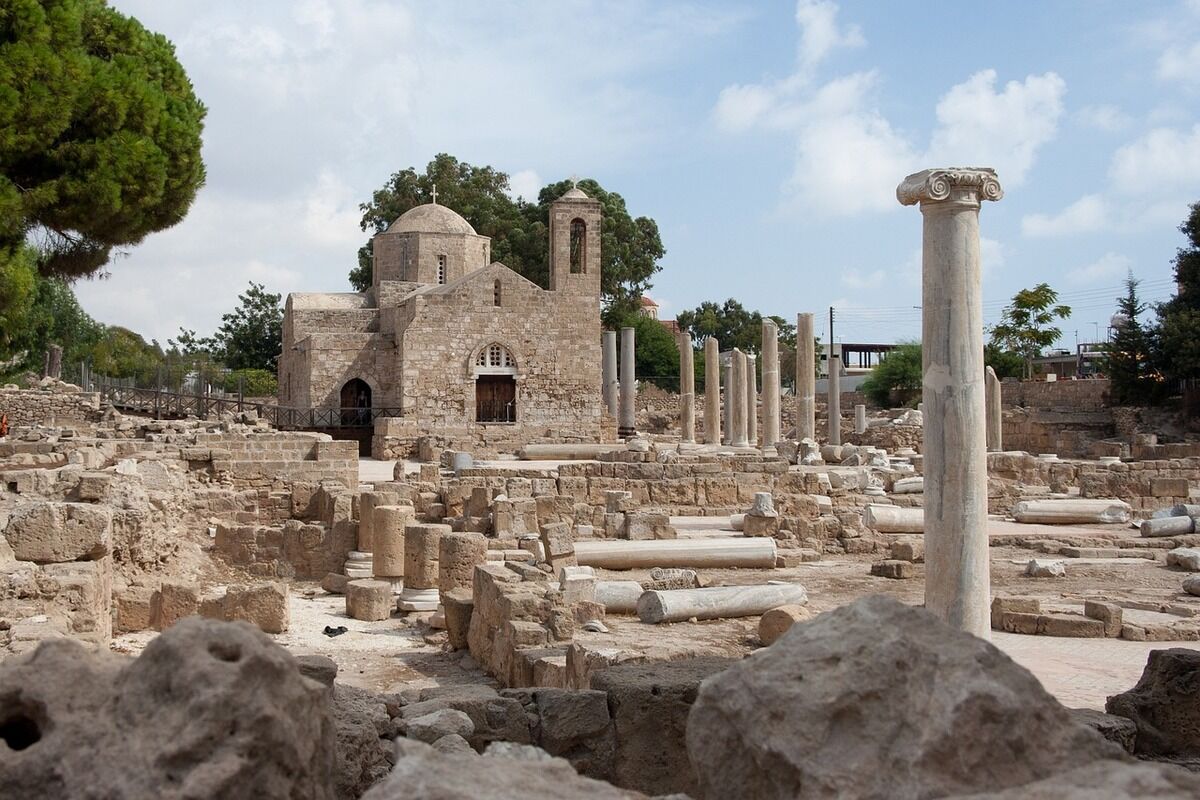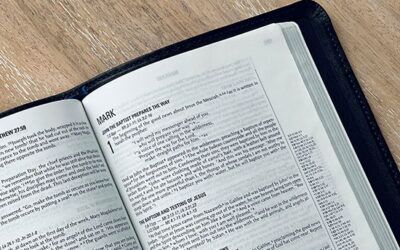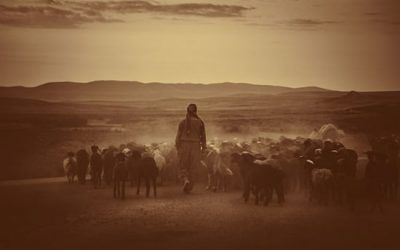What the Bible Says About Bartholomew the Apostle

Bartholomew is a lesser-known figure in the New Testament who is mentioned in each of the lists of the 12 disciples of Jesus Christ (Matthew 10:2-4; Mark 3:14-19; Luke 6:13-16). He is most likely the same individual as Nathanael (see John 1), someone who was sincerely studying the Scriptures and waiting for the Messiah to come.
His wait was no doubt rewarded when Jesus appointed him as one of the 12, and he had the opportunity to witness the Messiah’s healing, teaching, and preaching ministry. He also experienced the outpouring of the Holy Spirit at Pentecost, spurring his work as a missionary for Jesus.
So, let’s dig deeper into what the Bible, as well as some other historical Christian sources, can teach us about Bartholomew. We’ll cover:
Bartholomew’s background
The first time we read about Bartholomew is in Matthew 10:2-4:
“The names of the twelve apostles are these: first, Simon, who is called Peter, and Andrew his brother; James the son of Zebedee, and John his brother; Philip and Bartholomew; Thomas and Matthew the tax collector; James the son of Alphaeus, and Thaddaeus; Simon the Zealot, and Judas Iscariot, who betrayed him” (ESV).
The name Bartholomew gives us hints about his lineage. It was an Aramaic name that meant “son of Tolmai” or “son of Talmai” (in Aramaic, bar means “son”).1
Is Batholomew also known as Nathanael in the Bible?
Scholars believe that Bartholomew is the same person as Nathanael (mentioned in John 1:45). One commentary explains it like this:
“Nathanael was probably his own personal name. The Synoptic Gospels [Matthew, Mark, and Luke] make no mention of Nathanael, and the Gospel of John says nothing of Bartholomew. John mentions Nathanael, together with others of the Twelve, in a setting where it seems that none but disciples of the inner circle of Twelve were present (see ch. 21:2). Thus there is no valid reason for doubting that the two names Bartholomew and Nathanael refer to the same person.”2
In this case, Bartholomew was likely his family name, and Nathanael would have been his first name. It was common for Jews in the first century to have two names.
According to John 21:2, he came from Cana of Galilee. And it’s there that his friend Philip found him and invited him to meet Jesus (John 1:43-45).
Bartholomew’s discipleship
Any details beyond what’s already been mentioned, however, we’ll have to draw from other sources. Bartholomew is mentioned only a handful of times in the Gospel accounts.
The most we know about Bartholomew from Scripture, though, comes from his first encounter with Jesus (John 1:45-50).
The account gives us evidence of a close connection between Bartholomew and Philip, the disciple who invited him to meet Jesus. Interestingly, Bartholomew is also always listed right after Philip when the disciples are named in the Bible (Matthew 10:2-4; Mark 3:14-19; Luke 6:13-16).
When Philip found Bartholomew, he exclaimed:
“We have found him of whom Moses in the Law and also the prophets wrote, Jesus of Nazareth, the son of Joseph” (John 1:45, ESV).
This tells us that both Philip and Bartholomew were earnest students of the Scriptures. They were eager for the promised Messiah of the Old Testament.
And yet, Bartholomew was a bit skeptical: “Can anything good come out of Nazareth?” (verse 46, ESV).
Rather than arguing with him, Philip simply invited him to “come and see” (verse 46). And so, Bartholomew did.
He wasn’t disappointed.
When Jesus saw Bartholomew coming toward Him, He said, “Behold, an Israelite indeed, in whom there is no deceit!” ( verse 47, ESV).
What a high compliment! Jesus recognized the sincerity in him. Bible commentators note:
“Nathanael was one of that small but devout group who earnestly waited for ‘the consolation of Israel’ (see Luke 2:25) and aspired to the high ideals set before them by God.”3
Bartholomew was taken aback. “How do You know me?” he asked (verse 48, NKJV).
Jesus responded, “Before Philip called you, when you were under the fig tree, I saw you” (verse 48, NKJV).
Jesus had taken notice of his sincere longing for the Messiah. He knew him inside and out. This realization made Bartholomew exclaim:
“Rabbi, You are the Son of God! You are the King of Israel” (verse 49, ESV).
And so began his faithful discipleship with Jesus.
He got to witness first-hand what the Savior he had so desperately waited for was like. He experienced many of the key events of Jesus’ ministry, such as the feeding of the 5,000, as well as Jesus’ parables, sermons, and healing miracles.
During that time, Jesus sent him and the other disciples to preach, cast out demons, and serve those in need (Mark 3:14-19). Naturally, these experiences would’ve only increased his belief in Jesus and his understanding of His character.
But then came Jesus’ crucifixion. Bartholomew, like the other disciples, must have been frightened and confused by this turn of events (Matthew 26: 31, 56).
How could the savior he’d been waiting for…die?
But as he would discover, God’s plan didn’t end with the death of Jesus.

Photo by Manuel Sardo on Unsplash
Bartholomew and the other disciples were fishing with Simon Peter, no doubt still struggling with the shock and discouragement of Jesus’ death, when they found they couldn’t catch any fish (John 21:1-3).
But then, a man from the shore called out to them and told them to throw their net on the right side of their boat. When they followed his instruction, they ended up catching so many fish that they couldn’t even haul in their net (John 21:6).
It was then that the disciples realized this man was none other than Jesus, and that He’d been raised back to life (John 21:7,12).
Bartholomew and the other disciples must have been overcome with joy at the sight of their Savior.
But as Jesus would tell His disciples, their work wasn’t finished.
Bartholomew and the others would still have a role to play in telling others about Jesus and His gift of salvation.
Bartholomew’s life after Jesus’ ascension
Bartholomew was present at the ascension with the other disciples (except Judas) after Jesus’ resurrection.
He would’ve heard Jesus’ promise and commission for the disciples before He rose into Heaven: “But you will receive power when the Holy Spirit has come upon you, and you will be My witnesses in all Judea and Samaria, and to the end of the earth” (Acts 1:8, ESV).
Together with the other disciples, Bartholomew took those words to heart.
Acts 1:12-13 records that he went to Jerusalem and joined the disciples in the upper room. There, they prayed and waited for the outpouring of the Holy Spirit.
Acts 2 tells us the revolutionary results of those prayers. The disciples received the Holy Spirit “a rushing mighty wind,” and began to preach the good news of Jesus (verse 2, NKJV). All their fears were quieted, and they boldly shared about the one they loved.
Though we don’t know the details, we can assume that Bartholomew, like the other disciples, went from there and began to preach the Gospel as they were encouraged and empowered by the Holy Spirit.
According to a tradition taught by the church father Eusebius of Caesarea, Bartholomew went to India, taking with him “a Hebrew copy of The Gospel According to Matthew.”4
Other traditions say he went to Armenia, Ethiopia, Mesopotamia, Parthia (modern-day Iran), and Lycaonia (modern-day Turkey).5
Again, the Bible and other historical sources don’t tell us for sure, but it’s most likely that he died a martyr for his faith. Some sources suggest he was flayed and beheaded while others say he was crucified.6
Here’s a perspective expressed in Foxe’s Book of Martyrs about Bartholomew’s death:
“Preached in several countries, and having translated the Gospel of Matthew into the language of India, he propagated it in that country. He was at length cruelly beaten and then crucified by the impatient idolaters.”7
The bottom line is that Bartholomew was believed to have remained sincere and strong in his faith until the very end of his life. That he cherished his relationship with Jesus so much that he wasn’t willing to give it up for anything—not even to preserve his own life.
Bartholomew’s legacy

Photo by Fa Barboza on Unsplash
We may not know many details about Bartholomew the apostle, such as his life before following Christ, his day-to-day life as a disciple, or his accomplishments as an apostle. But what we do know about him leaves us a beautiful legacy.
He shows us what it looks like to have a heart sincerely seeking truth.
Nathanael, who we understand to be Bartholomew, was searching the Scriptures, wanting to be led by the Holy Spirit, wanting to see the Messiah (John 1:44-49). And Jesus took notice, commending him (verses 50-51).
His simple faith guided his journey as a disciple and later a missionary sharing the Gospel message. And his possible martyrdom means that he was making enough of a difference for Jesus that people would have taken notice.
But above all, Bartholomew’s example is a promise to us that Jesus indeed notices those who seek Him in sincerity and humility.
Even before Bartholomew met Jesus, Jesus knew Him. And it wasn’t just that Jesus had heard of him. He knew everything about him—his fears, disappointments, and dreams.
In the same way, Jesus knows us and longs to connect with us. He rewards everyone who seeks Him out. Even though it might seem like you’ve been waiting for a while, as Bartholomew waited for the Messiah, we can trust that Jesus answers when we call out to Him.
Today, we can follow Batholomew’s example by earnestly seeking Jesus in prayer and Bible study.
And as we search, we, like Bartholomew, will find a Savior and friend in Jesus.
Want to learn more about the disciples of Jesus? Brush up on all 12, or read about other lesser-known disciples like Thaddeus or James, son of Alphaeus.
- Metzger, Bruce, and Coogan, Michael, ed., The Oxford Companion to the Bible, pp. 75, 45. [↵]
- Seventh-day Adventist Bible Commentary, vol. 5, comment on Mark 3:18. [↵]
- Ibid., vol. 5, comment on John 1:47. [↵]
- “Saint Bartholomew,” Encyclopedia Britannica. [↵]
- Ibid. [↵]
- Ibid; Foxe, John, Foxe’s Book of Martyrs, chapter 1. [↵]
- Foxe. [↵]
Related pages
More Answers
Who is Mary Magdalene in the Bible?
Mary Magdalene was a remarkably dedicated follower and supporter of Jesus Christ during His earthly ministry.
Getting to Know Mark—Gospel Writer and Follower of Jesus
Mark (whose full name was John Mark) had a lot of roles in the New Testament: he was an early follower of Jesus Christ, he traveled the Mediterranean as a Christian missionary, and he wrote a book of the Bible.
Understanding Luke: The Beloved Physician, Historian, and Evangelist
Who was Luke in the Bible? What was he known for and what contributions did he make for the early church? Find out here.
Exploring the Life of the Apostle Paul
The apostle Paul went from Pharisee to Christian after a miraculous encounter with Jesus. He spent the rest of his life spreading the Gospel and writing words we still read today.
All About the Disciple, Simon the Zealot
“Simon the Zealot” was one of the 12 disciples chosen by Jesus Christ. But despite this important role, the New Testament doesn’t provide specific details about his life, family, job, etc.
Judas Iscariot, the Most Infamous Disciple of Jesus
Judas Iscariot is best known for betraying Jesus with 30 pieces of silver. This page looks more closely at who he was and what led him to do so.
Who Is Thaddeus, the Disciple?
Thaddeus (or Thaddaeus) is one of the more unique and obscure figures among Jesus Christ’s disciples in the New Testament. Though we know little about him from the Bible or tradition, we do know that he went by a few names, specifically Thaddeus, Lebbaeus, and Judas of James.
Matthew—From Tax Collector to Jesus’ Disciple
In the first book of the New Testament, we find the Gospel story from the perspective of Matthew. He was a Jewish tax collector from Capernaum in the first century AD, and he was likely despised by fellow Jews for choosing that profession.
Who Was Jesus’ Disciple Named James, Son of Alphaeus?
Two of Jesus’ 12 disciples were named James. While more is known about James the son of Zebedee and brother of John, let’s see what there is to know about the other James, known as James the son of Alphaeus—also sometimes referred to as “James the Lesser.”
What the Bible Tells Us About Thomas the Apostle of Jesus
You might know him as “Doubting Thomas” because he refused to believe in Jesus Christ’s resurrection without first seeing Jesus.
All About the Disciple James, Son of Zebedee
James the son of Zebedee was a fisherman who became Jesus’ disciple. Discover how his decision to follow Jesus shaped his life and the beginnings of the early Church.
Who was the Apostle John?
What does the Bible say about the apostle John? What is he known for today? Learn more about John’s life, ministry, and legacy here.
What Do We Know About Andrew the Disciple?
Andrew was Jesus Christ’s first disciple (John 1:37-40) and the first to recognize Him as the Messiah.
Simon Peter: Fisherman to Disciple to Apostle
Simon Peter was a simple fisherman who became one of the most well-known disciples of Jesus Christ. He is perhaps best known for being part of Jesus’ inner circle of three disciples, walking on water, and proclaiming Jesus as the Son of God.
Who Was Philip the Disciple In the Bible?
Philip was one of the 12 disciples called by Jesus Christ during His earthly ministry. He was originally from the city of Bethsaida and to this day is often known as the “practical disciple.”
King David: How Was He a Man After God’s Own Heart?
War, bloodshed, murder, adultery—all of these crimes overshadowed the life of a biblical Old Testament man named David. Yet he was called a man after God’s own heart, not to mention one of Israel’s greatest heroes and kings.
The Story of Moses in the Bible: What His Life Teaches Us
A baby on death row, an outcast prince, a humble shepherd, and an unlikely deliverer. All these titles describe the individual that led Israel out of slavery in Egypt to the borders of the Promised Land.
The 42 Kings (and 1 Queen) of Israel and Judah in the Bible
Conspiracies, royal scandals, dictatorships—history is full of them. And Bible history is no different when we stop to look at the kings of ancient Israel in the Old Testament.
Who Were the Israelites in the Bible?
The Israelites in the Bible, also known as the children of Israel or ancient Israel, were a nation God called to represent Him to the world. As recorded in the book of Exodus, He delivered them from slavery in Egypt under Moses’s leadership and brought them to the Promised Land of Canaan (located in a similar area to present-day Israel).
What We Can Learn from the Life of Joshua
Joshua was an iconic leader in the Old Testament of the Bible. As a successor to Moses, he was both a humble servant of God and a strong warrior. God called Him to lead the nation of Israel to take possession of Canaan, the Promised Land—a task he took on with faith and courage.
Why is Abraham Important in the Bible?
God communicated directly with Abraham and made a covenant with him that would provide land, protection, and fruitfulness for his descendants. And he indeed became the father of many nations, making him a foundational figure in three monotheistic world religions: Judaism, Islam, and Christianity (Genesis 17:5, 19-20; Genesis 25:1-6, 12-18).
Who Were the Judges of Israel in the Old Testament?
Times of crisis call for men and women of action. The Israelites, newly settled in the Promised Land, found themselves in those times. As enemy nations attacked and oppressed the tribes, they cried out to God for help. He, in turn, sent them men and women of action—known as judges.
Life Lessons from Joseph in the Bible
Joseph is one of the more well-known people from the Bible’s Old Testament. He showed remarkable strength, faith, and patience—even while facing great difficulty and injustice. All because he let God lead.
Didn’t find your answer? Ask us!
We understand your concern of having questions but not knowing who to ask—we’ve felt it ourselves. When you’re ready to learn more about Adventists, send us a question! We know a thing or two about Adventists.



























